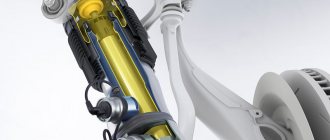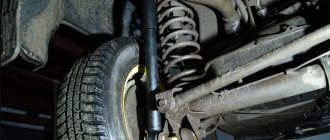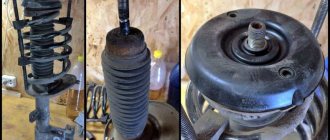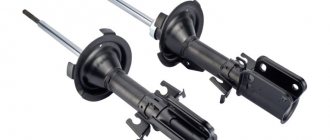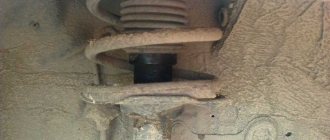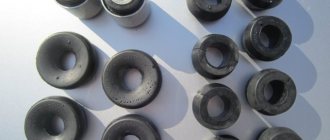Experienced drivers know how important it is to bleed the shock absorber before installing it. And it doesn’t matter whether it is oil or gas-oil (gas), from Kayaba or another manufacturer, for a VAZ 2107 or Mitsubishi OUTLANDER XL, if you do not pump the shock absorber strut (another name for the device) in a timely manner, this will negatively affect its performance and service life .
This will also allow you to timely identify a defective product and replace it under warranty.
And also, if the car has not been used for more than a year, it is also recommended to pump the shock absorbers, regardless of their type, because long-term parking adversely affects the optimal condition of the working compounds (oil, air, nitrogen).
Next we will tell you how to properly bleed oil, gas-oil (gas) shock absorbers before installing them.
Do I need to bleed shock absorbers before installation?
Gas remaining in the shock absorber, like air, is a common cause of knocks and noises during chassis operation. Therefore, it definitely needs to be pumped. If the requirement is not met, extraneous knocking and noise appears during the first ten thousand kilometers, which only intensifies over time. The suspension will begin to function with minor dips. “Death” marks jamming.
Do I need to bleed the struts before installation? Necessarily. Otherwise, the shock absorber rod, like the piston system in general, will not be able to fully perform its assigned tasks. At best, you will have to buy a new set of struts; at worst, this will lead to a traffic accident.
The shock absorber is stored in a warehouse in a horizontal position. This is due to the need to maintain the performance of the oil seals through constant contact with the lubricant. Long-term storage leads to spontaneous flow of liquid into the outer cylinder, and the freed volume is filled with air. The result is a partial loss of performance. That is why the driver needs to bleed the strut with his own hands.
Must know
During the pumping process, you must know the following rules:
— Any rack is pumped vertically (the rod should point upward);
— After pumping, you cannot change the position of the stand until it is
— There are shock absorbers whose design allows oil to be drained from the inner sleeve.
This is done like this: the shock absorber rod is pushed inward using a technological groove. It can be seen at the top of the stem.
Bleeding rear shock absorbers before installation
Bleeding is an easy procedure; new shock absorbers do not need to be sent to a service center. To properly pump the device, you need to follow this sequence of actions.
- Install the stand with the stem down. The base must be solid, ideally a concrete floor.
- Smoothly compress the product.
- We fix the position for two seconds.
- To get the rod back, you need to turn the shock absorber over and pull the tube out manually. Usually the rod rises without outside help.
- Leave the rod in the extended position.
- We repeat the procedure two or three more times.
After this, the rear struts can be installed on the lever or axle of the car.
Let's debunk the myth
On the eve of the step-by-step instructions for pumping, it is necessary to debunk one myth. There is a belief that a gas body vibration damper is only suitable for sports cars. The importance of high efficiency of gas workers when driving at high speed is emphasized. This is just a myth. A gas-filled shock absorber is suitable for everyone. It is installed on both family cars and station wagons. It all depends on the wishes of the car owner. But this should be within reasonable limits. It will be very funny to see a gas shock absorber on a domestic small car with a speed limit of 100 km/h.
How to bleed an oil shock absorber before installation
As mentioned earlier, everything, including oil shock absorbers, must be pre-bleeded before installation. The operating instructions supplied by the manufacturer indicate the correct sequence of actions.
- Vertical placement of the rack, the rod should be in the upper part.
- Recess the rod into the cylinder using little effort (your own weight is enough). You should leave a margin of three to four centimeters above the cut.
- Fix the device in the obtained position for four to five seconds.
- Smooth extension of the rod from the cylinder.
- Repeatedly turn the rack into a vertical position, pumping three or four times according to a similar principle.
That's all, the oil shock absorber can be installed on the car. According to my own observations, pumping automobile oil shock absorbers has the simplest principle.
Varieties
If a car enthusiast knows what shock absorbers he knows, then we will get something like this: oil, gas-oil and gas. This answer is partially correct. It is more correct to divide into two types: oil and gas.
This division is based on the use of different working substances. Gas shock absorbers use an inert gas, most often nitrogen, pumped under high pressure. In oil shock absorber struts, hydraulic oil and air or gas are pumped into the working space.
Structurally, they are divided into two types: two-pipe and single-pipe.
The first type of shock-absorbing struts is the most common due to its simplicity and low cost of manufacture. Oil or gas and oil are used as the working substance. The main disadvantage of oil shock absorbers is poor cooling of the working substance. The oil gets very hot due to its small working volume. High temperatures cause the oil to foam and the shock absorber stops working correctly.
Shock absorbers are structurally made into two-pipe and single-pipe. Oil and gas are pumped into the middle
Gas-oil shock absorber struts are partially free of this drawback. Oil and air are pumped into a two-pipe housing under a pressure of 2–3 atmospheres. Sometimes nitrogen is used instead of air. This solution reduces the likelihood of aeration - foaming of the oil.
This is interesting: Apple has taught iOS 7 to connect to machines
Structurally, monotube shock absorbers do not have a working chamber. It is replaced by the rack housing. The tube is divided into two sections. The upper part is filled with oil, and the lower part is filled with high pressure gas. There is a valve between the sections.
Gas shock absorbers are of particular interest to drivers. This is no accident. Gas struts are primarily used in motorsports. For sports driving, this type of rack is most often chosen. The operation of the gas shock absorber is ensured by pumped gas under high pressure. Such racks are the toughest and driving on city roads is accompanied by shocks and impacts. Such a ride cannot be called comfortable, but driving will be clear and controlled. Therefore, gas shock absorber struts are used mainly on racing cars.
A special type of shock absorbers are the so-called “reversals”. They were given this name not because they can be placed upside down. In such racks, the reverse position of the rod is used. In conventional shock absorbers, the rod is directed upward. In inversions, the rod is directed downwards and is attached to the shock-absorbing strut body. There is a pseudo-rod on top. It looks much thicker. The operation of the inverted shock absorber is ensured by several plain bearings. This design reduces the vertical and lateral load on the rack.
Bleeding gas-oil shock absorbers
Bleeding automobile gas-oil shock absorbers has a different preparation technology that allows you to bring the device into working condition.
- Place the device in a vertical position, the rod must be at the bottom and must rest against a flat surface.
- By applying a little force, you need to compress the stand without jerking.
- Fixation in the obtained position for two to three seconds.
- Reversing the shock absorber. Important - under no circumstances should the rod be released for three to six seconds.
- Release of the rod.
Important!
To inflate the gas-oil struts correctly, it is necessary to repeat the procedure six to eight times. After every fourth compression-decompression stroke, a check is carried out. It is necessary to ensure that the output to the extreme position occurs without noticeable problems and delays.
Process algorithm
It's time to find out how to bleed shock absorbers with your own hands. Below are step-by-step instructions:
1) We install the stand vertically on the concrete floor, with the stem down, and begin to smoothly compress;
2) Hold the rack in this position for two seconds;
3) Now you need to turn the shock absorber over, placing it with the rod up and pull it out (if necessary), sometimes the rod itself goes up.
4) Leave it in this position;
5) We repeat the operation, turn the rod down, hold for two seconds, then with the rod up - hold for six seconds. You can repeat this procedure up to six times.
It is worth noting that after the third pumping of the struts, it is advisable to check them for smoothness. To do this, shake the shock absorber in the position with the rod up several times with short movements. If the rod moves smoothly and does not fall anywhere, then everything is fine.
Until the final installation of the racks, they should not be moved. Can't tilt
shock absorber, do not turn it over, otherwise all your efforts will be in vain.
Now a short video.
The pumping process is completed. Now you can safely start replacing it yourself, if necessary. Remember that without proper bleeding, the service life is reduced several times. The instructions are written in clear and intelligible language, I especially tried to chew it as much as possible. I hope that I have helped all motorists, regardless of their experience, to believe in themselves and start repairing their cars on their own.
Read our AUTOBLOG.
( 8 votes, average: 4.38 out of 5)
After long-term use, shock absorbers require replacement. Installing them has some nuances. This concerns preliminary preparation for it. The main and most important stage is pumping. Failure to do so causes failure of the pistons of the part. Breakage in this case will not be a warranty case. Therefore, it is necessary to carry out pumping. The main signs of its absence are knocks and extraneous noises during shock absorber operation.
How to pump up struts with your own hands that were already on the car
If over time the car begins to behave on the road differently than before, it is necessary to check the condition of the suspension. To do this, the strut is removed from the spring and then checked. Used copies also need pumping, even if the seller assures that everything is fine with them and they do not need additional manipulations.
The principle of performing the work remains the same. But the main attention is paid to the behavior of the rod when returning to its original position. If even after 6-8 up and down movements the rack works in the same way, this indicates its severe wear. There is no need to install it on a car. There are two options - buying a new set, or handing it over to a specialist for restoration.
Operating principle
It doesn't matter how the shock absorber is designed. All of them, regardless of type, operate on the same principle
This means that, regardless of type, they need pumping. In the shock absorber chamber, the piston performs a reciprocating movement. The piston has several holes. As the mechanism moves, the pressure in the chamber increases. By the way, it becomes larger when the car moves at low speed.
What happens if you don’t bleed the shock absorber before installation?
The procedure discussed is necessary to put the shock absorber strut into working condition. This provides:
- comprehensive removal of residual lubricant or air from the space of the inner sleeve. Failure to follow this procedure will lead to failure of the shock absorber unit after 10-15 thousand kilometers (sometimes earlier);
- early detection of defects and potential malfunctions in box shock absorbers, expressed in the form of sticking of the valve block.
Note! According to the experts who service the suspension at service centers, it is enough to pump the unpacked shock absorber three times. In their opinion, a one-time pumping is not enough to bring the part back to life.
When installing a new shock absorber without preliminary pumping, after 3-5 thousand kilometers, an incomprehensible noise and knocking will occur. After another 5-7 thousand kilometers the strut will jam. It is unlikely that it will be possible to return it to good condition.
Let us inform inexperienced drivers: only twin-tube shock absorbers require bleeding. The exception is a single-pipe new copy. The operating principle is designed so that the oil does not enter the gas chamber, because the latter is under high pressure. The result is that excess air cannot accumulate. A sealed piston is responsible for this, separating the two media from each other.
If you accidentally pump a single-pipe product, it will not damage it. Young owners who do not understand the difference between a single-pipe and a two-pipe device should still do control pumping. On the one hand, this will not harm the single-pipe design. On the other hand, this will take at most five minutes of free time, and it will be possible to avoid potential malfunctions in the future.
Bleeding is a simple procedure that does not require contacting a service station technician. By following the rules, the device will last its entire operational life.
What is the difference between gas-oil products and oil products?
From the name itself it is already clear that their main difference is the working composition that is used inside the device.
In oil shock absorbers, the working space is filled with hydraulic oil.
The main disadvantage of these types of devices is aeration (oil foaming), which occurs as a result of changes in the physicochemical properties of the liquid when a piston acts on it in a small space.
This is manifested by a failure in the operation of the device and uncharacteristic sounds.
A partial reduction in aeration is achieved by replacing air with nitrogen gas; as a result, gas-oil analogues have appeared, which come in one or two pipes.
Single-pipe ones are often called gas ones, because there the oil and gas are separated by a movable jumper and do not mix.
IMPORTANT TO KNOW: Causes of shock absorber knocking.
Strong backpressure ensures gas pressure in the region of 10 - 30 atmospheres; there are also regulated analogues. Mainly installed on sports cars.
Twin-pipe gas-oil shock absorbers have less gas pressure - from 3 to 10 atmospheres.
But he won’t delve into the topic, because that’s not what you came here for. The shock absorber structure can be seen in the photo below.
conclusions
As a result of pumping, the shock absorber receives the necessary functionality. It will work correctly, and the service life will increase by 40% compared to the unpumped version. You should not neglect pumping the gas-filled mechanism, otherwise the upgrade will not live up to your expectations.
The best prices and conditions for the purchase of new cars
All existing types of vibration damping devices are divided into oil and gas shock absorbers . These vibrations arise from the action of the suspension while the car is moving, and the focus of our article is intended to compensate for them. Otherwise, the car will sway violently in all directions, even at low speeds. The balance of the car is disrupted, and it becomes impossible to move at high speed.
Technology for pumping McPherson struts and cartridges
- Install the rack or cartridge with the rod up and smoothly, without jerking, compress it to a certain point (the working surface of the rod should not reach the top of the rack glass by 2-3 cm);
- Fix the shock absorber rod in this position for 2-3 seconds;
- Smoothly pull out the rod until it is fully extended;
- Repeat operations A, B, C 2-3 times;
- Holding the shock absorber vertically, with the rod up, perform a control operation (with sharp but short movements of the rod, make sure that the piston moves smoothly, without failures). In well-pumped shock absorbers, the piston moves smoothly without dips (please note that in some shock absorbers, when fully decompressed, the valve mechanism may enter the compensation cavity, designed to expand the shock-absorbing fluid when warmed up, and not provide any resistance).
Based on materials from the site: https://www.kybcom.ru/prokachka.html
Video of pumping shock absorber struts
Learn more about how to properly bleed your strut by watching the video:
Bleeding shock absorber struts is a mandatory procedure before installation on a vehicle. It will help identify manufacturing defects and prepare the shock absorber for proper operation. A pumped strut will last much longer, and driving will become safe and comfortable. Don't forget about it!
- Author: Dmitry Kuznetsov
Let's get acquainted, my name is Dmitry Kuznetsov. Rate this article:
- 5
- 4
- 3
- 2
- 1
(12 votes, average: 3.8 out of 5)
Share with your friends!
